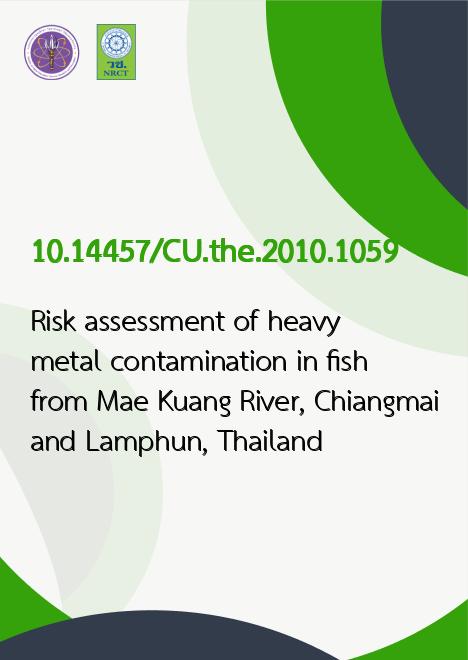
|
Risk assessment of heavy metal contamination in fish from Mae Kuang River, Chiangmai and Lamphun, Thailand |
|---|---|
| รหัสดีโอไอ | |
| Title | Risk assessment of heavy metal contamination in fish from Mae Kuang River, Chiangmai and Lamphun, Thailand |
| Creator | Chanagun Chitmanat |
| Contributor | Siripen Traichaiyaporn, Piamsak Menasveta, Robson, Mark Gregory |
| Publisher | Chulalongkorn University |
| Publication Year | 2553 |
| Keyword | Fishes -- Effect of heavy metals on -- Thailand -- Chiang Mai, Fishes -- Effect of heavy metals on -- Thailand -- Lamphun, Heavy metals, Water -- Pollution, Pollution -- Measurement, Pollution -- Risk assessment |
| Abstract | The objectives of this study aimed: i) to determine the physico-chemical status of water in the Mae Kuang River; ii) to compare the results of heavy metals including cadmium (Cd), lead (Pb), and zinc (Zn) in water, sediment, and fish tissues ; iii) to study the speciation of Cd, Pb, and Zn in sediments along Mae Kuang River; iv) to identify responses in exposed fish; v) to investigate a possible protective effect of Kai algae (Cladophora and Microphora) as fish supplementary diet against lead-induced toxicity in catfish. Pb and Cd in water were below detection limits, while Zn concentrations in water ranged 0.01 – 0.11 ppm. The Pb, Cd and Zn concentrations in sediment were 3.13 – 27.56, <0.02 – 0.43 and 3.42 – 10.32 mg/kg, respectively. Pb and Cd residues in snakehead fish (Channa striata) were <0.05 – 2.13 and <0.02 – 0.24 mg/kg wet weight, while the concentrations of Zn in these fish were 3.37 – 12.19 mg/kg. Biological indices including hepatosomatic index, serum glucose, catalse, lysozyme activity could highlight some exposure effects in fish living in contaminated ecosystems, but their application of these effects in field biomonitoring may not be easily predictable in complex mixtures of contaminants. African fish fed with Kai showed increased growth, blood cells, and lysozyme (P < 0.05) compared with the control group. Following exposure with Pb, more lyzozyme and catalase activities were observed in the group fed the experimental diets than the control group (P < 0.05). These results indicate that Kai supplementation is useful in prevention catfish from Pb toxication but it could not reduce Pb accumulation. The information gained from this research will be valuable for heavy metal contamination monitoring in river. In addition, it provides the guideline for the development of diet to mitigate fish stress from deteriorated environment. |
| URL Website | cuir.car.chula.ac.th |